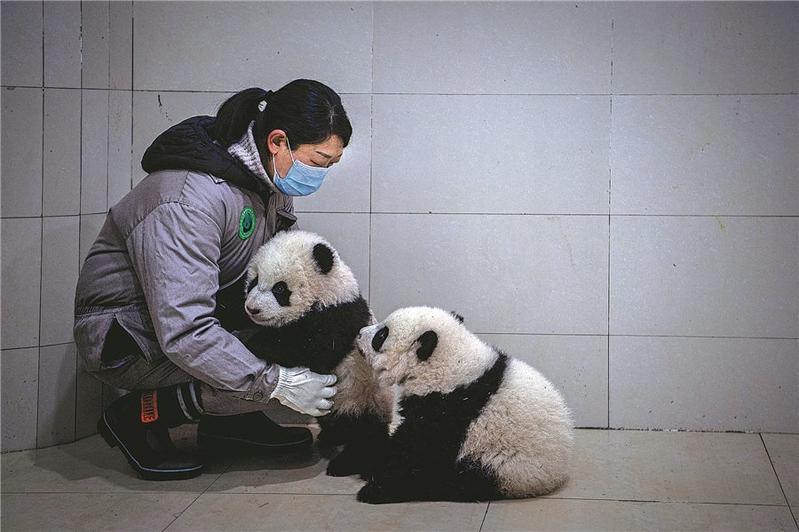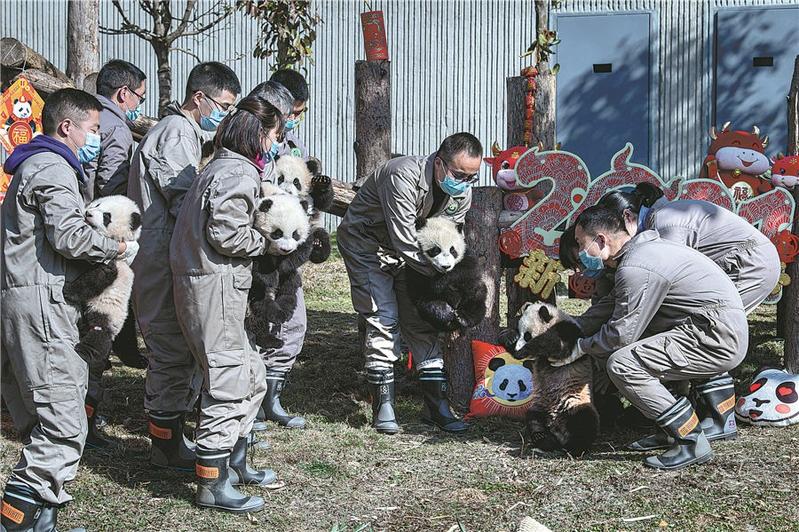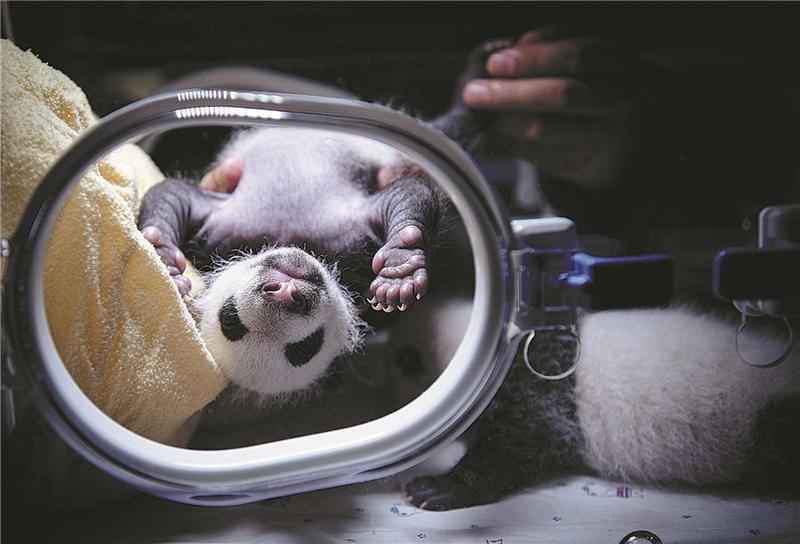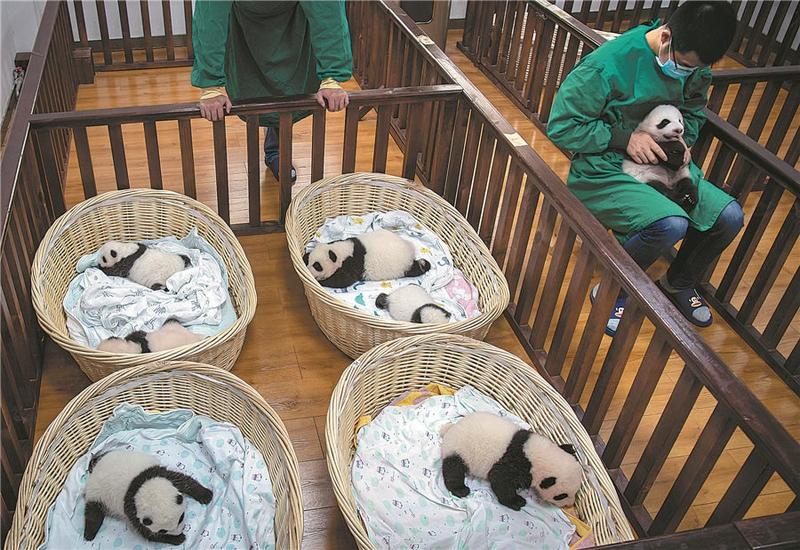 A staff member at the Shenshuping base takes care of a pair of giant panda twins born in 2020. (HE HAIYANG/FOR CHINA DAILY)
A staff member at the Shenshuping base takes care of a pair of giant panda twins born in 2020. (HE HAIYANG/FOR CHINA DAILY)
On the morning of Dec 26,2021, large swathes of snowflakes suddenly landed on the Shenshuping base of the China Giant Panda Conservation and Research Center in Southwest China's Sichuan province.
The giant panda Pingping is playing in the park with two four-month-old cubs, and they see the snow falling from the sky for the first time. They roll in the snow, a new sensation and skill on their growing path.
At the Shenshuping base in the Giant Panda National Park, 24 cubs from 15 embryos were bred in 2021, including nine pairs of twins. It marked a 100 percent survival rate. Since July 17, 2021, the returnee giant panda Zhenzhen gave birth to a pair of male twin cubs, and the panda center officially entered the calving season. After Zhenzhen saw her first cub, she immediately held it in her arms to soothe the newborn baby.
 Ten giant pandas born in 2020 participate in the New Year's greeting ceremony. (HE HAIYANG / FOR CHINA DAILY)
Ten giant pandas born in 2020 participate in the New Year's greeting ceremony. (HE HAIYANG / FOR CHINA DAILY)
Fresh bamboo leaves were prepared for the nursing panda mothers in the pen. The giant panda is very protective when it comes to motherhood. Even during eating, they hold the cub in their arms, always vigilant against anyone approaching.
From this time on, the giant panda cubs enjoys a comfortable life in the national park. Zhenzhen is a returnee giant panda, born in 2007 at the San Diego Zoo in the United States, and returned to the Panda center in 2010.In 2015, it gave birth to twins in Bifeng Gorge, Ya'an, Sichuan.
 Zhenzhen's one-month-old cubs have a thorough physical check-up in the incubator. HE HAIYANG/FOR CHINA DAILY
Zhenzhen's one-month-old cubs have a thorough physical check-up in the incubator. HE HAIYANG/FOR CHINA DAILY
After giving birth to the twins, a panda can only nurse one of the cubs, and the other is artificially bred. In the nursery of the center, the nursery staff become "daddies" to carry out the hard work of "taking care of the baby". As giant pandas are born premature, the development of various organs is incomplete. Consequently, defecation and feeding are all completed with the help of the nursery staff.
ALSO READ: Giant panda conservation in SW China a blessing for rare species
 In this undated photo, a nurse prepares to weigh the giant panda cub. (HE HAIYANG / FOR CHINA DAILY)
In this undated photo, a nurse prepares to weigh the giant panda cub. (HE HAIYANG / FOR CHINA DAILY)
A nursery is usually occupied by two "dads", and they can at most take care of nine panda cubs. Li Dehong, an animal care expert says the artificial breeding of newborn cubs cannot allow even the slightest margin of error, and like human babies, the "dads" must feed milk every two hours. After the end of feeding, the bottles and measuring cups are all disinfected, and they then have to register the amount they have given.
Basically, after doing this, they start the process again with another round of feeding. The panda cubs grow up healthy and strong under their care, and when they are able to crawl, they return to their mothers and explore nature together.
 In this undated photo, a nurse helps a panda cub defecate. (HE HAIYANG / FOR CHINA DAILY)
In this undated photo, a nurse helps a panda cub defecate. (HE HAIYANG / FOR CHINA DAILY)
Li Guo, an expert at the Shenshuping base's management office, says that the high birthrate of twins in the base last year reflects the improvement of the management level of giant panda breeding, indicating that the ex-situ protection of giant pandas has achieved promising results.
With the increase in the number of captive giant pandas, it can provide a solid guarantee for the training and release of giant pandas and the introduction of giant pandas in the wild.
China has established a relatively complete system of nature reserves. Large areas of natural ecosystems have been systematically and completely protected, and wildlife habitats have been effectively improved. Since the 1960s, China has established 67 giant panda nature reserves.
 Two nurses look after eight panda cubs born in 2021. (HE HAIYANG / FOR CHINA DAILY)
Two nurses look after eight panda cubs born in 2021. (HE HAIYANG / FOR CHINA DAILY)
Since the establishment of China's first Wolong Nature Reserve in 1963, Sichuan has established 46 giant panda nature reserves. The implementation of the Tianbao project, returning farmland to forest, artificial breeding research, the rewilding and repatriation experiments, the protection and restoration of the giant panda habitat, and the recovery and growth of wild and captive giant panda populations have been realized.
READ MORE: Pigeon pair panda cubs born in China's Chongqing
As of July last year, the number of giant pandas in the wild has reached more than 1,800, and the level of threat has been reduced from endangered to vulnerable.


